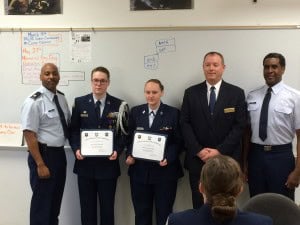
Through its curriculum and leadership training, the Junior Reserve Officer Training Corps program prepares students for a three- or four-year ROTC scholarship at more than 1,000 colleges and universities.
Fortunately for Seneca High School students, their school is the only one in the Lenape regional district that offers the Air Force program.
Before participating in the JROTC Physical Fitness program, all cadets are required to complete the AFJROTC Physical Fitness Program Cadet Participation Consent Form and health screening questionnaire.
All cadets are required and expected to wear the uniform, meet grooming standards and participate in the scheduled PT activities each week. This is all in addition to the prerequisite aviation science, leadership education, and health and wellness classes.
The goal of the JROTC program is to develop citizens of character dedicated to serving their nation and community.
Last month, it was confirmed that Seneca High School’s chapter is doing a remarkable job of just that.
Seneca’s JROTC Unit NJ-20101 earned an overall unit assessment score of “exceeds standards,” the highest rating attainable during its rated unit evaluation on March 14.
Program leaders Maj. (Ret.) Sean P. Hoggs and Master Sgt. (Ret.) John Brooks were recognized for creating a dynamic and supportive learning environment coupled with an excellent community outreach.
“What separates the passing groups from the exceeding standards groups is the approach,” Hoggs noted. “You really have to take it upon yourselves to cross your t’s and dot your i’s.”
The assessment is a tri-annual evaluation conducted by the regional director from the headquarters of the AFJROTC for all high schools nationwide who wish to keep their program running.
It consists of a set of rigorous protocols and research-based processes for evaluating an institution’s organizational effectiveness. It examines the whole institution to determine how well the parts work together to meet the needs of students.
The schools are evaluated on everything from community involvement to curriculum presentation to how the group wears their uniforms.
“They want to make sure that we are teaching what the Air Force wants the high schools to learn properly,” Hoggs said. “They also look to make sure there is a certain degree of cadet ownership and the program is not being dictated by the majors.”
The program is sent a checklist of everything it will be evaluated on during its assessment so there are no secrets, but Hoggs said it takes months of preparation and is certainly not something you will receive a good score on if you attempt to throw together in a few weeks.
“It’s intense,” he said.
With more than 24 years of military experience, Hoggs has seen it all, and even he had trouble recalling another group he had worked with that was as extraordinary as this Seneca unit.
“I’m very proud of the growth of this program. What they’ve put together has been remarkable,” he said.
He had a hard time finding words that did a justice when describing the impact senior cadets Tyler and Trevor Barton have had on the program.
“Two outstanding individuals,” Hoggs said. ”They provided a prime example of putting something on your back and just willing it to succeed.”
“You see a handful of blue chip athletes on the sports fields and in the gyms, but these guys are blue chip, highly gifted athletes themselves,” he said.
Denying all credit, he also humbly acknowledged junior cadet Emily Earley and the overall support of the school’s administration and principal.
However, HQ Director of AFJROTC Col. Bobby Woods, Jr. said the Seneca instructors provide outstanding leadership themselves in administering the cadet-centered citizenship program.
Hoggs and his counterpart Brooks have known each other for several years, and Hoggs described their situation at Seneca as the perfect storm when it comes to accomplishing all of their goals.
“I feel very fortunate to be in the position I am,” he said.









